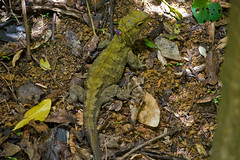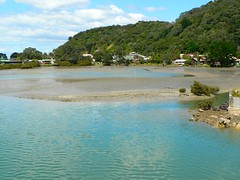Dinosaurs believed to be ten million years older than first thought:
The oldest known dinosaur relative, Asilisaurus kongwe, appears with an early sail-backed dinosaur in an artist's rendering.
A new dinosaur relative found in Tanzania is the oldest known creature of its kind—a discovery that pushes back the origin of dinosaurs by at least ten million years, paleontologists say.
Dubbed Asilisaurus kongwe, the Labrador retriever-size creature was a silesaur, the closest relatives to true dinosaurs. The newfound animal lived 243 million years ago, during the middle Triassic period.
Since silesaurs and true dinosaurs diverged from a common ancestor, the two groups should have existed during the same time frame. But the oldest known true dinosaurs date back to just 230 million years ago.
Finding a silesaur that's ten million years older makes "a big difference," said study co-author Christian Sidor, curator of vertebrate paleontology at the Burke Museum of Natural History and Culture in Seattle.
Asilisaurus's age suggests that some early forms of dinosaurs must have also been plodding around in the middle Triassic. (See a prehistoric time line.)
"When people think about dinosaurs, we think about the extreme forms, the ones that have gone off in their ... own weird directions," such as Stegosaurus and Tyrannosaurus rex, said Thomas R. Holtz, Jr., a vertebrate paleontologist at the University of Maryland, who was not involved in the research.
"But they all came from a common ancestor, and fellows like Asilisaurus help us understand what that original dino state looked like."
Early Dinosaur Relative an Omnivore?
Parts of at least 12 Asilisaurus skeletons were found in 2007 in southern Tanzania's Ruhuhu Valley. With no intact specimen to study, Sidor and his team had to piece together a composite skeleton.
What emerged looked nothing like what paleontologists had imagined.
Instead of resembling the "typical hatchet-headed, blade-toothed meat-eaters," Asilisaurus was a light, slender-limbed animal with peg-like teeth and a small beak-like structure on its jaw, the University of Maryland's Holtz said.
The shape of the beak suggests Asilisaurus tore into tissue, which means the animal might have eaten plants—or both plants and meat, the researchers say.
Mysteriously, the long-tailed animal ran on all fours—even though the vast majority of early dinosaurs were two-legged carnivores, according to the study, to be published tomorrow in the journal Nature.
"It's making the picture a little bit murkier, because we have a possible herbivore and quadruped very close to the dinosaur lineage," said study co-author Sidor, who received funding for the research from the National Geographic Society's Committee for Research and Exploration. (The National Geographic Society owns National Geographic News.)
Dinosaurs' World in Transition
In a way, Asilisaurus's discovery "is an elegant fulfillment of a prediction," said Christopher Brochu, a vertebrate paleontologist at the University of Iowa who also wasn't part of the study group.
That's because paleontologists know dinosaurs belong to the archosaurs. Within this group, dinosaur ancestors are divided into two main branches: a line that includes silesaurs and shares skeletal features with modern birds, and a line that has more in common with crocodilians.
Since a crocodilian dinosaur-ancestor from the middle Triassic had already been found, unearthing an animal like Asilisaurus was just a matter of time.
But the new research goes beyond that, Brochu said. "It's part of a larger, growing realization that the earliest archosaurs were far more diverse than we ever thought."
In addition to finding Asilisaurus, study leader Sidor and colleagues have already collected several other archosaur species from the Ruhuhu Valley—many more than in other archosaur hot spots.
It's unknown why the lush, wet valleys of prehistoric Tanzania produced so many strains of dinosaur relatives, paleontologists say.
Whatever the reason, "what we're seeing here is a picture of a world in transition," Brochu said. "It's really a fascinating time in the history of life."
Acknowledgements: NewsTrust: National Geographic.
Labels: dinosaurs, new discovery, ten million years older
 Image by PhillipC via Flickr
Image by PhillipC via Flickr![Reblog this post [with Zemanta]](http://img.zemanta.com/reblog_e.png?x-id=8fafb606-7842-4f68-bff8-8d69a9befbb4)

![Reblog this post [with Zemanta]](http://img.zemanta.com/reblog_e.png?x-id=a34d8c89-2d47-4cc9-8375-aa01925971fe)

![Reblog this post [with Zemanta]](http://img.zemanta.com/reblog_e.png?x-id=3ca0546e-3417-4366-be65-51833da3bae2)


![Reblog this post [with Zemanta]](http://img.zemanta.com/reblog_e.png?x-id=d9764395-26cc-4d97-bcd7-0e81ef522215)
